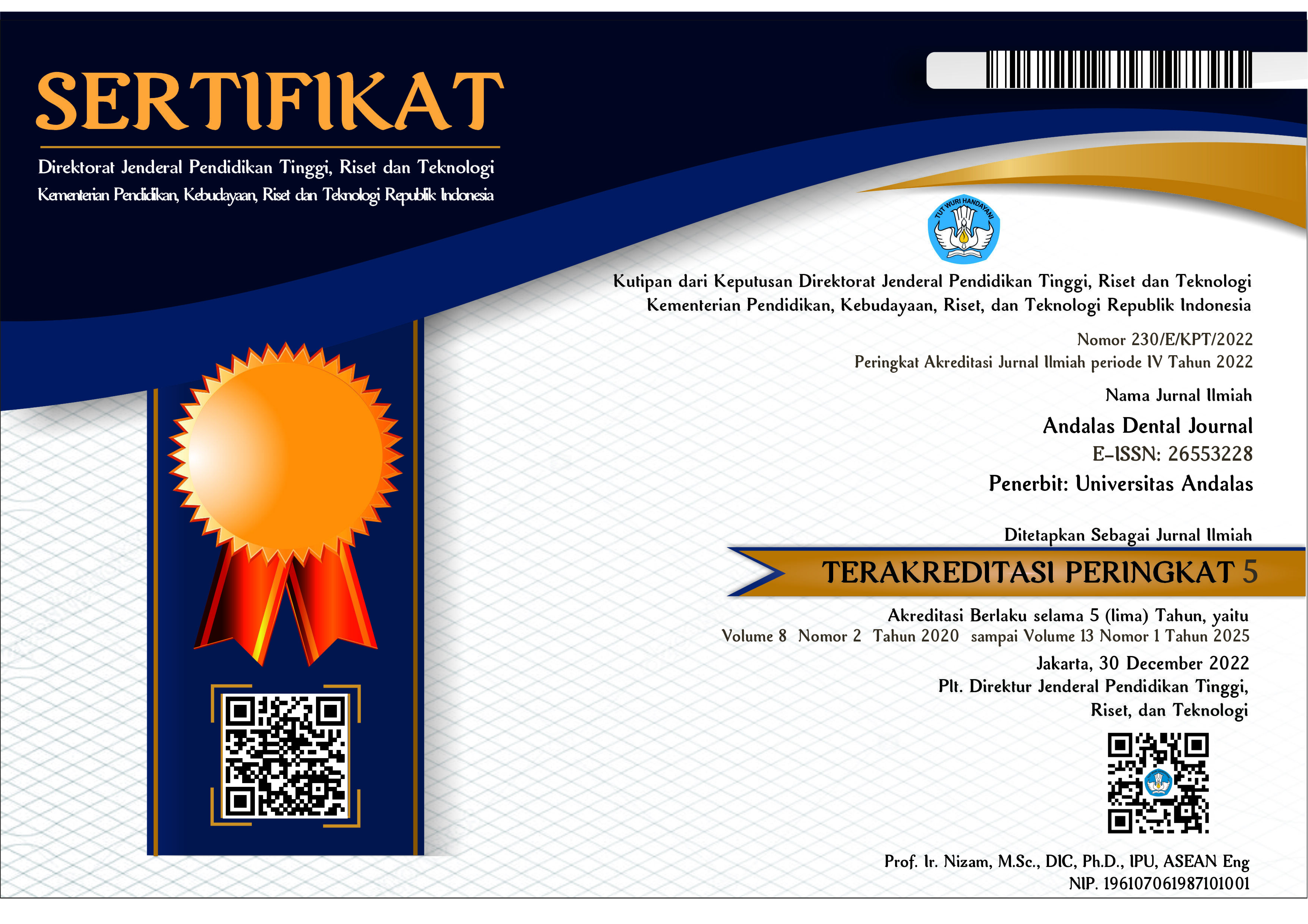PERBANDINGAN DRAINING METHOD DENGAN SPITTING METHOD TERHADAP VOLUME SALIVA MAHASISWA FAKULTAS KEDOKTERAN GIGI UNIVERSITAS ANDALAS ANGKATAN 2011 DENGAN STIMULASI AROMA MAKANAN
Abstract
Saliva has been used in diagnostic procedures. Draining method and spitting method are a saliva collection method that is often used for diagnostic and therapeutic purposes based saliva. The purpose of this research is to determine comparison of draining method and spitting method to saliva volume students of Dentistry Faculty Andalas University class of 2011 with aroma of food stimulation. This observational research with cross sectional study approach has been held to 17 students of Dentistry Faculty in Andalas University class of 2011 that ages are 20-21 years old that is matched with the inclusion criteria. The volume of saliva collected is expressed in unit of ml. Univariate data analysis is carried out to describe each variables, to see normal distribution (p > 0,05) Shapiro Wilk normality test is performed. After distribution is proven to be normal, dependent T-test is performed to determine the mean differences between the draining method and the spitting method. Based on dependent T-test, average saliva volume students of Dentistry Faculty in Andalas University class of 2011 with the draining method is x ± SD = 2,5 ± 1,11 ml and the volume of saliva by spitting method is x ± SD = 3,72 ± 1,84 ml and p value < 0,05. Based on the research finding, it can be concluded that there are significant differences in the average saliva volume in the spitting method is higher than the draining method.
References
2. Pratiwi, Dea Raissa, Deby Kania Tri Putri, Siti Kaidah. 2014. Efektivitas Penggunaan Infusum Daun Sirih (Piper betle Linn) 50% dan 100% sebagai Obat Kumur Terhadap Peningkatan pH dan Volume Saliva. Dentino Jurnal Kedokteran Gigi, Vol II. No 2 September 2014 : 167-173.
3. Ferraro, Maria, Alexandre R. Vieira. 2010. Explaining Gender Differences in Caries : A Multifactorial Approach to a Multifactorial Disease. Hindawi Publishing Corporation. International Journal of Dentistry Volume 2010, Article ID 649643, 5 pages.
4. Indriana, Tecky. 2011. Perbedaan Laju Aliran Saliva dan pH karena Pengaruh Stimulus Kimiawi dan Mekanis. J. Kedokteran Meditek Vol 17, No. 44, Mei- Agust 2011.
5. Navazesh, Mahvash and Satish K.S. Kumar. 2008. Measuring Salivary Flow : Challenges and Opportunities. JADA 2008 ; 139 (suppl 2) : 35S-40S.
6. Brosky, Mary Elizabeth. 2007. The Role of Saliva in Oral Health : Strategies for Prevention and Management of Xerostomia. The Journal of Supportive Oncology, Volume 5, Number 5 May 2007.
7. Walsh, Laurence J. 2007. Clinical Aspects of Salivary Biology for The Dental Clinician. International Dentistry South Africa. Volume 2. 16-30.
8. Guyton, Arthur C, John E Hall. 2012. Buku Ajar Fisiologi Kedokteran. EGC. Jakarta.
9. Wong, David T. 2008. Salivary Diagnosis. Wiley Blackwell. Singapore.
10. Arhakis, Aristidis, Vassilis Karagiannis, Sotirios Kalfas. 2011. Sampling Small Volumes of Saliva for Determination of The Stress Hormone Amylase. A Comparative Methodological Study. Journal of Behavioral and Brain Science, 2011, 1, 194- 198.
11. Agrawal, RP, Sharma N, Rathore MS, Gupta VB, Jain S, Agarwal V, Goyal S. 2013. Noninvasive Method for Glucose Level Estimation by Saliva. Journal Diabetes Metab, Volume 4.
12. Raju, Shashidara, Sudheendra Udyavara Sridhara, Aparna H. Gopalkrishna, Vanishri C. Haragannavar, Ketki Sali. 2014. Chromatography Paper : A Novel Approach to Estimate The Salivary Flow. Journal of Advanced Clinical & Research Insights (2014), 1, 7-9.
13. Chiappin, Silvia, Giorgia Antonelli, Rosalba Gatti, Elio F. De Palo. 2007. Saliva Specimen : A New Laboratory Tool for Diagnostic and Basic Investigation. Clinica Chimica Acta 383 (2007). 30-40.
14. Prabhakar, AR, Akanksha Gulati, Deepak Mehta, Sugandhan S. 2009. Diagnostic Applications of Saliva in Dentistry. International Journal of Clinical Pediatric Dentistry, September-December 2009;2 (3) ; 7-13.
15. Yamachika, Shigeo, Ken Yamamoto, Yoshiaki Nomura, Hiroyuki Yamada, Ichiro Saito, Yoichi Nakagawa. 2012. Clinical Factors Influencing the Resting and Stimulated Salivary Flow. Open Journal of Stomatology. 2012, 2, 103-109.
16. Nogourani, Maryam Karami, Mohsen Janghorbani, Raha Kowsari Isfahan, Mozhgan Hosseini Beheshti. 2012. Effects of Chewing Different Flavored Gums on Salivary Flow Rate and pH. International Journal of Dentistry. Volume 2012.
17. Rohleder, Nicolas, Urs M. Nater. 2009. Determinants of Salivary α Amylase in Humans an Methodological Considerations.Psychoneuroendocrinology (2009) 34, 469—485.















